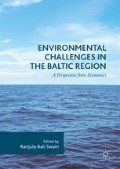Abstract
This chapter assesses the key factors related to travel mode choice by the citizens of Tallinn, specifically comparing the growing use of cars and diminishing use of public transport, based on household travel survey data collected in 2015. Although the number of trips made and daily time spent on travelling in Estonia is still lower than in highly developed countries, these figures are rapidly increasing. Besides income, another important factor promoting car use is the car compensation offered by employers and enabled by the Estonian tax system. While looking at why people choose cars or public transport, the authors underline the need for a public transport or cycling network to satisfy citizens’ needs. The role of urban planning is crucial to developing the quality and accessibility of public transport.
Access this chapter
Tax calculation will be finalised at checkout
Purchases are for personal use only
References
Anspal, S., & Poltimäe, H. (2009). Model of social costs of transport: Methodology and results (Report for Ministry of Economic Affairs and Communications).
Buehler, R. (2011). Determinants of transport mode choice: A comparison of Germany and USA. Journal of Transport Geography, 19(4), 644–657.
Carse, A., Goodman, A., Mackett, R. L., Panter, J., & Ogilvie, D. (2013). The factors influencing car use in a cycle-friendly city: The case of Cambridge. Journal of Transport Geography, 28, 67–74.
Cats, O., Reimal, T., & Susilo, Y. (2014). Public transport pricing policy—Empirical evidence from a fare-free scheme in Tallinn, Estonia. Transportation Research Record: Journal of the Transportation Research Board, 2415, 89–96.
Cats, O., Susilo, Y., & Reimal, T. (2016). The prospects of fare-free public transport: Evidence from Tallinn. Transportation, 1–22.
Dargay, J., & Gately, D. (1999). Income’s effect on car and vehicle ownership, worldwide: 1960-2015. Transportation Research Part A: Policy and Practice, 33(2), 101–138.
de Palma, A., & Rochat, D. (2000). Mode choices for trips to work in Geneva: An empirical analysis. Journal of Transport Geography, 8(1), 43–51.
Eesti Uuringukeskus. (2012). Tallinn travel survey, commissioned by Tallinn City Government.
Environment Agency. (2016). Data about car population and mileage in Estonia. Provided by email, March 30, 2016.
Eriksson, L., Friman, M., & Gärling, T. (2008). Stated reasons for reducing work-commute by car. Transportation Research Part F: Traffic, Psychology and Behaviour, 11(6), 427–433.
Eurostat. (2016). Statistical database. http://ec.europa.eu/eurostat. Accessed August 22, 2016.
Gardner, B., & Abraham, C. (2007). What drives car use? A grounded theory analysis of commuters’ reasons for driving. Transportation Research Part F: Traffic Psychology and Behaviour, 10(3), 187–200.
Giuliano, G., & Dargay, J. (2006). Car ownership, travel and land use: A comparison of the US and Great Britain. Transportation Research Part A: Policy and Practice, 40(2), 106–124.
Iftekhar, S., & Tapsuwan, S. (2010). Review of transportation choice research in Australia: Implications for sustainable urban transport design. Natural Resources Forum, 34(4), 255–265.
Jüssi, M., Poltimäe, H., Sarv, K., & Orru, H. (2010). Sustainable transport report commissioned by Sustainable Development Committee and the Estonian Government Office.
Kingham, S., Dickinson, J., & Copsey, S. (2001). Travelling to work: Will people move out of their cars. Transport Policy, 8(2), 151–160.
Kuhnimhof, T., Buehler, R., Wirtz, M., & Kalinowska, D. (2012). Travel trends among young adults in Germany: Increasing multimodality and declining car use for men. Journal of Transport Geography, 24, 443–450.
Metz, D. (2010). Saturation of demand for daily travel. Transport Reviews, 30(5), 659–674.
Mokhtarian, P. L., Salomon, I., & Singer, M. E. (2015). What moves us? An interdisciplinary exploration of reasons for traveling. Transport Reviews, 35(3), 250–274.
Monzon, A., Vega, L. A., & Lopez-Lambas, M. E. (2011). Potential to attract drivers out of their cars in dense urban areas. European Transport Research Review, 3(3), 129–137.
Poltimäe, H. (2014). The distributional and behavioural effects of Estonian environmental taxes. Ph.D. Dissertation. University of Tartu Press.
Schwanen, T., Dijst, M., & Dieleman, F. M. (2002). A microlevel analysis of residential context and travel time. Environment and Planning, 34, 1487–1507.
Statistics Estonia. (2016). Statistical database. http://www.stat.ee. Accessed August 8, 2016.
Steg, L. (2005). Car use: Lust and must. Instrumental, symbolic and affective motives for car use. Transportation Research Part A: Policy and Practice, 39(2–3), 147–162.
TNS EMOR. (2015). Tallinn travel survey, commissioned by Kredex.
Acknowledgements
The authors would like to thank the Tallinn City Government, Ministry of Economic Affairs and Communications and Kredex for making available Tallinn travel survey data for 2012–2015. The authors are also grateful to Patrik Dinnétz for his useful comments while acting as a discussant for the draft version of this study.
Author information
Authors and Affiliations
Corresponding author
Editor information
Editors and Affiliations
Rights and permissions
Copyright information
© 2017 The Author(s)
About this chapter
Cite this chapter
Poltimäe, H., Jüssi, M. (2017). Factors Affecting Choice of Travel Mode in Tallinn. In: Bali Swain, R. (eds) Environmental Challenges in the Baltic Region. Palgrave Macmillan, Cham. https://doi.org/10.1007/978-3-319-56007-6_6
Download citation
DOI: https://doi.org/10.1007/978-3-319-56007-6_6
Published:
Publisher Name: Palgrave Macmillan, Cham
Print ISBN: 978-3-319-56006-9
Online ISBN: 978-3-319-56007-6
eBook Packages: Economics and FinanceEconomics and Finance (R0)

